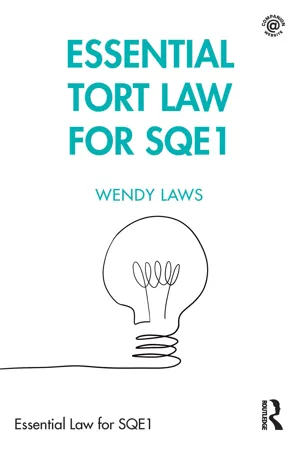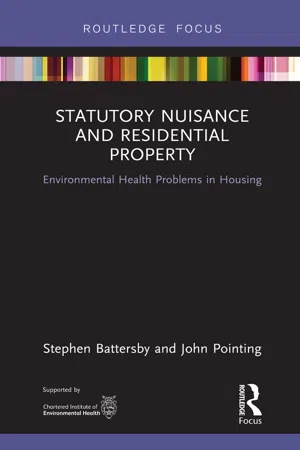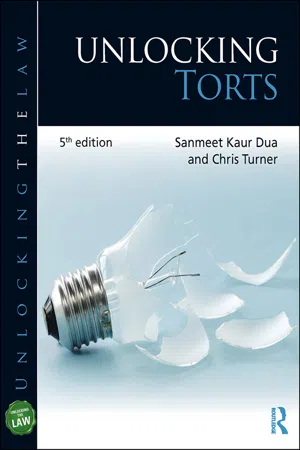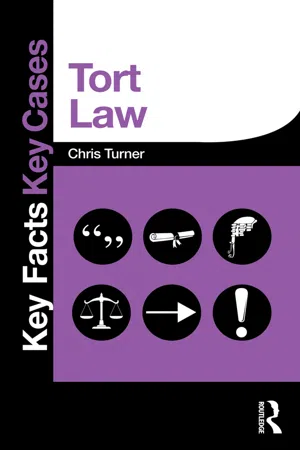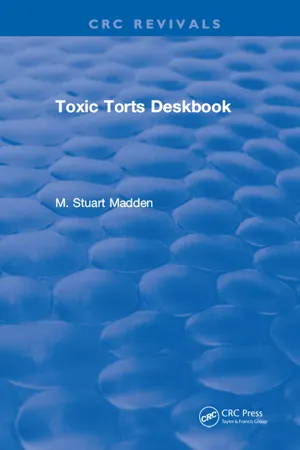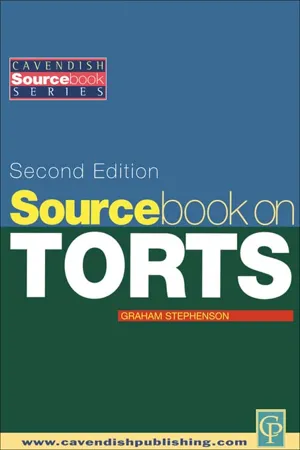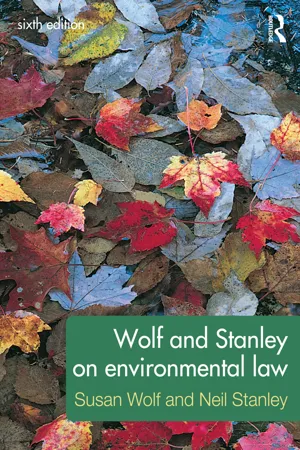Law
Public Nuisance
Public nuisance refers to an unreasonable interference with the general public's right to enjoy public spaces or property. This can include activities or conditions that cause harm, inconvenience, or obstruction to the community. Examples of public nuisance may include excessive noise, pollution, or obstructing public roads. It is a legal concept that aims to protect the public's well-being and enjoyment of public spaces.
Written by Perlego with AI-assistance
7 Key excerpts on "Public Nuisance"
Learn about this page
Index pages curate the most relevant extracts from our library of academic textbooks. They’ve been created using an in-house natural language model (NLM), each adding context and meaning to key research topics.
- eBook - ePub
- Wendy Laws(Author)
- 2021(Publication Date)
- Routledge(Publisher)
The land on the site is contaminated by chemicals which are injurious to health. The operations on the site cause contaminated mud and dust to spread across the town, so endangering the health of the public. A number of individual claimants suffer personal injury as a result of this contamination, and they seek damages in compensation for their injury. 1 1 See Corby Group Litigation v Corby DC [2009] EWHC 1944 (TCC), [2010] Env LR D2, on which this example is based. A building contractor excavates a hole in a public highway outside the main entrance to a shop. The hole blocks the highway for a number of months, causing inconvenience to the public by preventing them from passing by. The owner of the shop also suffers a loss of profits because the interference with the highway substantially reduces the number of customers coming to the shop, and she seeks damages for this loss. In cases like these, consideration would be given to a claim in Public Nuisance. The key feature of these cases is that the defendant’s activities have interfered with the comfort and convenience of a whole class of the public. 18.3 Definition A Public Nuisance is something which interferes with the reasonable comfort and convenience of a class of the public. 2 2 See Attorney General v PYA Quarries Ltd (No.1) [1957] 2 QB 169 (CA). The requirement for the interference to affect a class of the public means that a sufficiently large number of people must be affected. Whether a sufficient class of the public has been affected for the interference to amount to a Public Nuisance is a question of fact in each case. To amount to a Public Nuisance, the interference must be unreasonable. Consider, for example, disruption caused by the creation of an obstruction or danger on the public highway (as in our example in Section 18.2) - eBook - ePub
Statutory Nuisance and Residential Property
Environmental Health Problems in Housing
- Stephen Battersby, John Pointing(Authors)
- 2019(Publication Date)
- Routledge(Publisher)
94.11 This is a very wide definition, criticised by some for being vague and much too wide.10 In order to engage with the nuisance limb of statutory nuisance, a Public Nuisance will need to endanger “the health and comfort of the public at large”.11 This does not mean that everyone in the neighbourhood must be affected by a Public Nuisance. But if only a few people are affected or if the nuisance is such that a number of individuals are each separately victims of a private nuisance, then a Public Nuisance will not be made out. In R v Rimmington , Lord Roger opined that “a core element of the issue of Public Nuisance is that the defendant’s act should affect the community, a section of the public, rather than simply individuals”.12Statutory nuisance
4.12 In the rest of this chapter, we will be concerned with aspects of the statutory nuisance regime affecting the occupation of residential property. We are particularly concerned with two types of statutory nuisance: first, with those arising from the state of the premises – s.79(1)(a) EPA 1990, and secondly, with noise emitted from premises – s.79(1)(g).4.13 As with nearly all forms of statutory nuisance, those arising from the state of the premises and noise are required to fall within one or other of the two limbs of the statutory nuisance regime. Section 79 EPA 1990 stipulates that a statutory nuisance must be “prejudicial to health or a nuisance”. These two limbs are alternative requirements, but it is not required that an abatement notice drafted to regulate a statutory nuisance stipulates the limb under which the enforcement action is being taken.13 - eBook - ePub
- Sanmeet Kaur Dua, Chris Turner(Authors)
- 2019(Publication Date)
- Routledge(Publisher)
9Nuisance
AIMS AND OBJECTIVES
After reading this chapter you should be able to:■ Illustrate the differences between private nuisance, Public Nuisance and statutory nuisance■ Explain what determines who the potential parties are in each action■ Identify elements for proving private nuisance■ Explain the requirements for proving Public Nuisance■ Define the scope of statutory nuisance■ Apply the defences available to a claim of nuisance■ Critically analyse the tort of nuisance■ Apply the law to factual situations and reach conclusions as to liability9.1 Nuisance generally
Nuisance is perhaps the part of tort law which is most closely connected to protection of the environment. As will be seen, action in nuisance can lie for oil spills, nasty smells, noise and anything else which affects nearby land or the comfort and convenience of the occupiers of that land.The problem of pollution, whatever form it takes, is also the subject of statutory regulation, much of which stems from regulations and directives coming from the European Union. As seen in Chapter 1 , the European Convention on Human Rights and the Human Rights Act 1998 are also having an impact, providing a remedy where either the common law or statute fails to do so.Nuisance may take three forms:■ private nuisance■ Public Nuisance■ statutory nuisance.As will be seen these are not necessarily mutually exclusive of each other but the traditional method of discussing each separately will be followed.Figure 9.1 Land.Nuisance is concerned with the use of land. We have already seen that the word ‘land’ has an extended meaning in law (Chapter 8.3 - 5 Nuisance5.1 Private nuisance5.1.1 The definition, character and purpose of the tort1 Defined as ‘continuous, unlawful and indirect interference with a person’s enjoyment of land or some right over, or in connection with it’.2 It only applies to an ‘indirect’ interference – direct is trespass.3 It concerns prevention more than compensation.4 It concerns the relationship between neighbours.5 There are three key elements to neighbourhood:continuity – involving a recurring state of affairs;people should be free to use their land as they wish, so long as it does not harm their neighbours;neighbours are subject to many trivial disputes, so there is a risk of the courts being flooded with claims.6 Only ‘unreasonable’ interference is a nuisance:so there is no protection against interference classed as reasonable;but if classed as unreasonable it is irrelevant whether it was reasonable for the defendant to engage in such behaviour.7 The test is: what conduct is sufficient to justify legal intervention?8 The court must strike a balance between conflicting interests and this now involves balancing the rights of the individual against that of the wider community even where violation of human rights (Article 8) is involved (Hatton v UK (2003); Dennis v MoD (2003); Marcic v Thames Water Utilities Limited
- eBook - ePub
- M. Stuart Madden(Author)
- 2018(Publication Date)
- CRC Press(Publisher)
16 4.4 Public NuisancePublic Nuisance is defined widely as “an unreasonable interference with a right common to the general public.”17 The Restatement, Second, Torts § 821B states that “circumstances” that might give rise to the conclusion that defendant’s activity creates an unreasonable interference with a public right include evaluation of: “(a) whether the conduct involves a substantial interference with the public health, the public safety, the public peace, the public comfort or the public convenience, or (b) whether the conduct is of a continuing nature or has produced a permanent or long-lasting effect and, to the actor’s knowledge, has a substantial detrimental effect upon the public right.” It can be seen readily that the protections within the Public Nuisance remedy may pertain to toxic harms where a wide and accidental dispersal of toxins affect the public health, comfort, or convenience.Defendant’s conduct may create a cause of action in Public Nuisance even where “neither the plaintiff nor the defendant acts in the exercise of private property rights.”18 For example, in Burgess v. M/V Tomano,19 commercial clam diggers and fishermen were permitted to pursue a Public Nuisance claim, premised on an off coast oil spill, even though it was “uncontroverted” that “the right to fish or to harvest clams in Maine’s coastal waters is not the private right of any individual, but is a public right held by the State ‘in trust for the common benefit of the people’.”20 - eBook - ePub
- Graham Stephenson, Graham Stephenson(Authors)
- 2012(Publication Date)
- Routledge-Cavendish(Publisher)
1 These mechanisms for protecting the environment are a valuable addition to the common law, although it would seem that the reverse is true, in that the common law controls in most cases will surely be taking a back seat in the fight against environmental damage. The common law may be seen as the backdrop against which the other controls now operate. We shall be considering the scope of the common law actions only in this chapter, although often the solution may lie in the public law domain.The second point of an introductory nature is that the tort comprises two separate and, possibly historically distinct, causes of action, that is, public and private nuisance. Whilst it is true that they are independent actions, they often overlap and the same set of facts may well give rise to an action in both and, in addition an action under the rule in Rylands v Fletcher, assuming for the moment that that is a distinct cause of action.DISTINCTION BETWEEN PUBLIC AND PRIVATE NUISANCE
A Public Nuisance is normally considered to be an interference or misuse which either (a) affects the exercise of some public right; or (b) substantially affects the health, safety, or convenience of a substantial number of people within the area of effect. Private nuisance is commonly regarded as an unreasonable interference with the use or enjoyment of the claimant's land or recognised interest in land.Public Nuisance, it must be emphasised, is a crime as well as a tort, whereas private nuisance is a tort only. A civil action for a Public Nuisance would normally be brought by the Attorney General in what is known as a relator action, although the frequency of resort to this procedure has been considerably reduced by the introduction of the public law controls mentioned above. A private individual may bring an action in Public Nuisance provided she can show that she has suffered special damage over and above that suffered by the community at large. A private individual must take the initiative at all times in a private nuisance action.Public Nuisance protects a wider range of interests in that the claimant need not have an interest in land, as is generally thought to be the case, in a private nuisance action. Personal injury damages are definitely recoverable in a Public Nuisance action provided the claimant can show special damage as mentioned earlier. In private nuisance, as with the rule in Rylands v Fletcher, - eBook - ePub
- Susan Wolf, Neil Stanley(Authors)
- 2013(Publication Date)
- Routledge(Publisher)
25Where there is no actual physical damage to person or property, but only a reduction in the enjoyment of a property (for instance, as a consequence of loud noise or offensive smells), the courts have also indicated that much will depend upon the location where the nuisance is complained of. In the often-quoted case of Sturges v Bridgman (1879),26 Thesiger LJ stated that ‘what would be a nuisance in Belgrave Square would not necessarily be so in Bermondsey’.27 This narrow approach is problematic in the context of environmental protection. Environmental problems often transcend spatially defined areas, and should not be seen in such narrow terms. Moreover, it is precisely in the industrial, urban and run-down areas where there are more likely to be statutory nuisances occurring. There can be no justifiable reason why in these more vulnerable areas the protection of the law should be less than in those areas where the chances of statutory nuisances occurring are more remote.9.3.3 Interference with personal comfortThe common law test for private nuisance is that there is an interference to property or the enjoyment of property. However in Wivenhoe Port v Colchester BC (1985),28 the Court of Appeal stated that, in the context of statutory nuisance, nuisance did not have its wide common law meaning but should be confined to personal discomfort. In the judgment, Butler J made the following statement:To be within the spirit of the Act [PHA 1936] a nuisance, to be a statutory nuisance, had to be one interfering materially with the personal comfort of the residents, in the sense that it materially affected their well-being although it might not be prejudicial to their health. Thus, dust falling on motor cars might cause inconvenience to their owners; it might even diminish the value of their motor car; but this would not be a statutory nuisance. In the same way, dust falling on gardens or trees, or on stock held in a shop would not be a statutory nuisance. But dust in eyes or hair, even if not shown to be prejudicial to health, would be so as an interference with personal comfort.29
